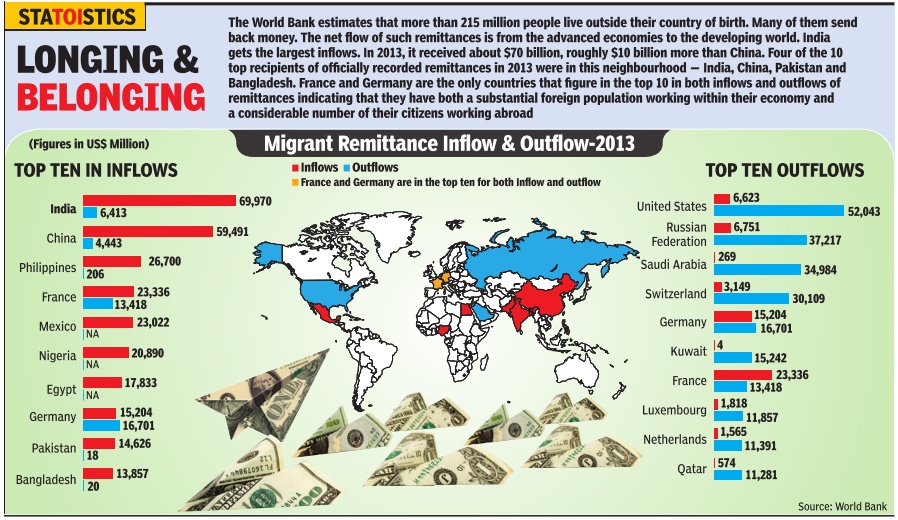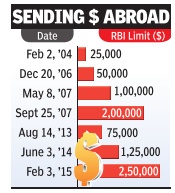Remittances: South Asia
This is a collection of articles archived for the excellence of their content. |
Contents |
Quantum of remittances
= BRIDGING THE GULF
The Times of India Dec 01 2014
India gets the highest amount of remittances in the world at roughly $70 billion, almost three times the amount of FDI that comes into the country. Where does all this money come from? Data shows that the bulk of remittances come from three different categories of countries: Middle Eastern monarchies such as Qatar, Western developed nations such as the US or Australia, and next door neighbors such as Bangladesh and Nepal. By far the largest amount comes from the Gulf countries -Qatar, Bahrain, Oman, Saudi Arabia, and Kuwait -which sent a combined $32.7 billion, almost half of all remittances received.
Migrant remittances: 2013

Outward remittances
The remittance limit: 2015
Buying a house overseas easier now
Mumbai TIMES NEWS NETWORK The Times of India Feb 04 2015
RBI Increases Forex Remittance Limit To $250,000Year As Reserves Swell
Buying a house overseas, which used to be the preserve of the super rich, has now become a lot easier for wealthy Indians with the Reserve Bank of India doubling the foreign exchange remittance limit to $250,000 per individual per year. In other words, a family of four can remit $1 million (equivalent of Rs 6.2 crore) every year to purchase assets overseas. With this move, the rupee has become almost fully convertible for most Indians. The funds remitted overseas can be used for almost any activity barring a few such as speculation in exchanges, funding terror groups or for remittances to Bhutan, Nepal, Mauritius and Pakistan.
According to Bank of India chairperson V R Iyer, the increase in the liberalized remittance scheme to $2.5 lakh reflects the confidence of the regulator in consistency in foreign inflows.
RBI governor Raghuram Rajan said on Tuesday the foreign currency remittance limit was relaxed following a review of the external sector outlook and as a further exer cise in macro prudential management. The central bank also said that it will ask the government to subsume under this limit various remit tances that an individual is allowed under the Foreign Exchange Management Act, which include donations, gift remittances and exchange facilities for those seeking employment overseas and for maintenance of close relatives abroad. Until now, this facility was in addition to remittance limits already available for private travel, business travel, studies, medical treatment, etc as described in Schedule III of Foreign Exchange Management (Current Account Transactions) Rules, 2000.
An improvement in the country’s foreign exchange re serves has emboldened the RBI to increase the limit. Announcing his policy , Rajan said the following the drop in oil prices the current account deficit has been comfortably financed by net capital inflows, mainly in the form of buoyant portfolio flows and supported by foreign direct investment inflows and external commercial borrowings.
“Accordingly, there was accretion to India’s foreign exchange reserves to the tune of $6.8 billion in Q3,” said Rajan. The sensex fell 122 points on Tuesday to close at 29,000 because of RBI’s decision to maintain status quo on rates and a sell-off in PSu banks due to worsening asset quality. FII selling added to the slide, dealers said.
The day’s session started on a better note with the index opening about 100 points higher. After the RBI said that it was keeping the key policy rates unchanged due to lack of data since its last rate cut, the index started giving up gains and at one point was down over 200 points.
In volatile trades, finally the index closed 0.4% lower with banking and financial services sector stocks among the top laggards.
While FIIs were net sellers in the stock market, in the debt segment they got more freedom to invest in the government securities market. In its policy, RBI allowed foreign investors to plough back their interest earnings from gilts into the same instrument, in effect increasing their exposure limit in government securities.
With the current FII gilt limit at $30 billion, at the current gilt yield, foreign investors can invest an additional $2.5 billion in gilts next year, bond dealers pointed out. This will also help in government’s debt auction by channelizing more funds into the gilt market, they said.
Remittances: Inward and reverse
The Times of India, Dec 03 2015
Vibhor Mohan Reverse Remittances: Survey Finds 9% Of Punjabi Households Send Money Abroad
The success of NRIs is often judged by the amount of money they send back home as remittances.But now, perhaps for the first time, an out-migration survey of 10,000 households in Punjab has found that 9% of them send money to their relatives in different parts of the world.
As expected, 71% of the respondents having family members abroad confirmed regular receipts. But that a substantial number send money outside India -reverse remittance -indicates that the foreign dream may not always be as rosy as it is made out to be.
The study -`Dynamics of International Out-Migration from Punjab', sponsored by the Centre for Research in Rural and Industrial Development (CRRID), Chandigarh and the Institut Nation al d'Études Démographiques (INED), Paris -points out that among those doing re verse remittance, the highest rates were recorded among households with a large landholding (21%).
“Reserve remittance is a relatively untouched aspect of the migration story and even the Central government often doesn't have figures on it,“ said Professor Aswini Kumar Nanda of CRRID, who conducted the study with Jacques Véron (INED). “There are households in Punjab that are obsessed with the idea of settling their child abroad and would sell off property to realise this dream.“
Households with the highest standard of living (14%), those in south Punjab's Malwa region (13%) and general caste (non-SCnonOBC) households (12%) are among those that show reserve remittance.
“Such a pattern of reverse remittance among the households with out-migration experience points to a presence of a section of wealthy or highly networked emigrants -with capacity to raise required resources from market or non-market sources,“ says the report.
Around one-tenth of all the surveyed households in Punjab received remittances at some point. NRI-rich Doa ba -Hoshiarpur, Kapurthala, Jalandhar and Nawanshahr -reports higher incidence of remittance receipts (21%).
If, instead of all households only those that have at least one current interna tional out-migrant are considered, the incidence of remittances increases substantially -from 10% to 71%. The study reveals that three-fifths (roughly 6,000) of households send money abroad to meet the immediate needs of the `departing' member or to provide some support initially after landing on foreign soil for accommodation, food, communica tion, clothing and transport.
69% of families `3L to sent `1.5L-` kin abroad earlier
Data indicates that during the five-year period before the survey, 69% of households sending remittances abroad had sent up to a total of Rs 1.5 lakh each, followed by 23% of households sending amounts ranging from Rs 1.5 lakh to Rs 3 lakh each. The share of households with high volume of reverse remittance (more than Rs 3 lakh) was estimated to be around 8%.
Also, 12% of households received as little as Rs 10,000 or even less as transfer receipts from their family members or relatives abroad.
Remittances used for daily needs, debt repayment
Four-fifths of the households used remittances for day-to-day consumption (including for food, fuel, clothing, footwear, etc.), followed by two-fifths for debt repayment.
Also, 34% and 31% of the households used income from abroad for seeking health care and education.
Remittances are also used for savings, housing (construction, repair and renovation) and social ceremonies such as weddings by 14%, 10% and 7% of households, respectively.
See also
Remittances: South Asia

